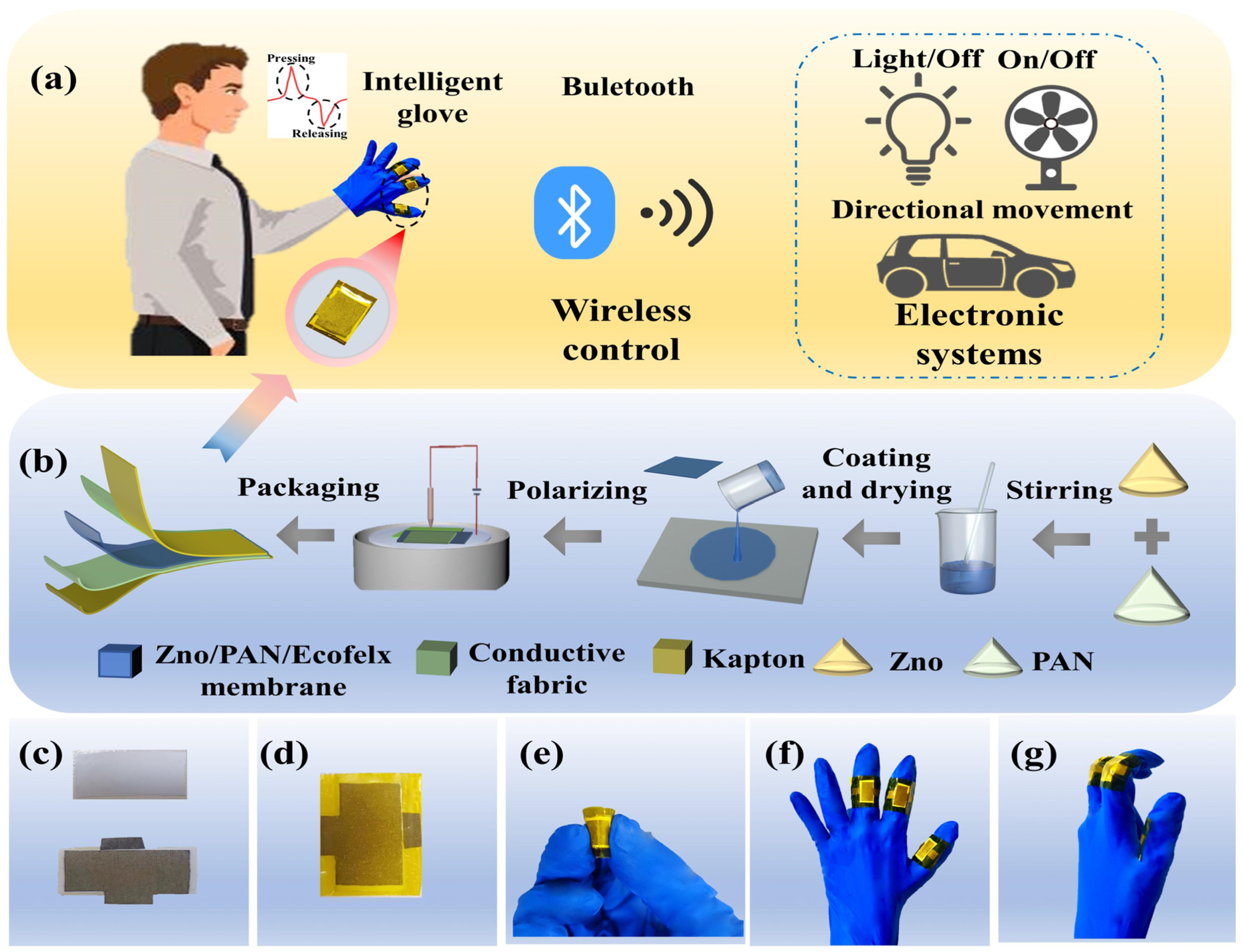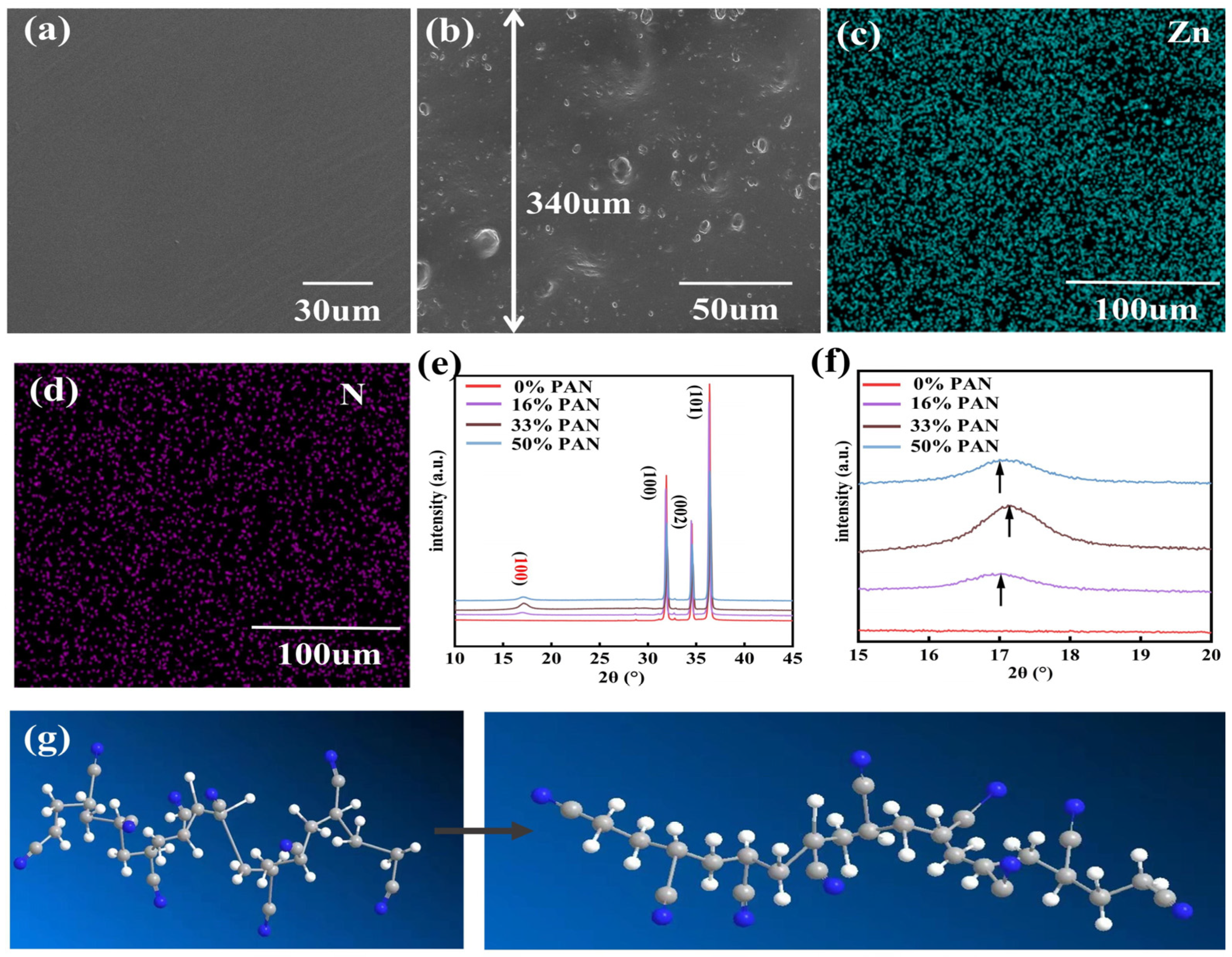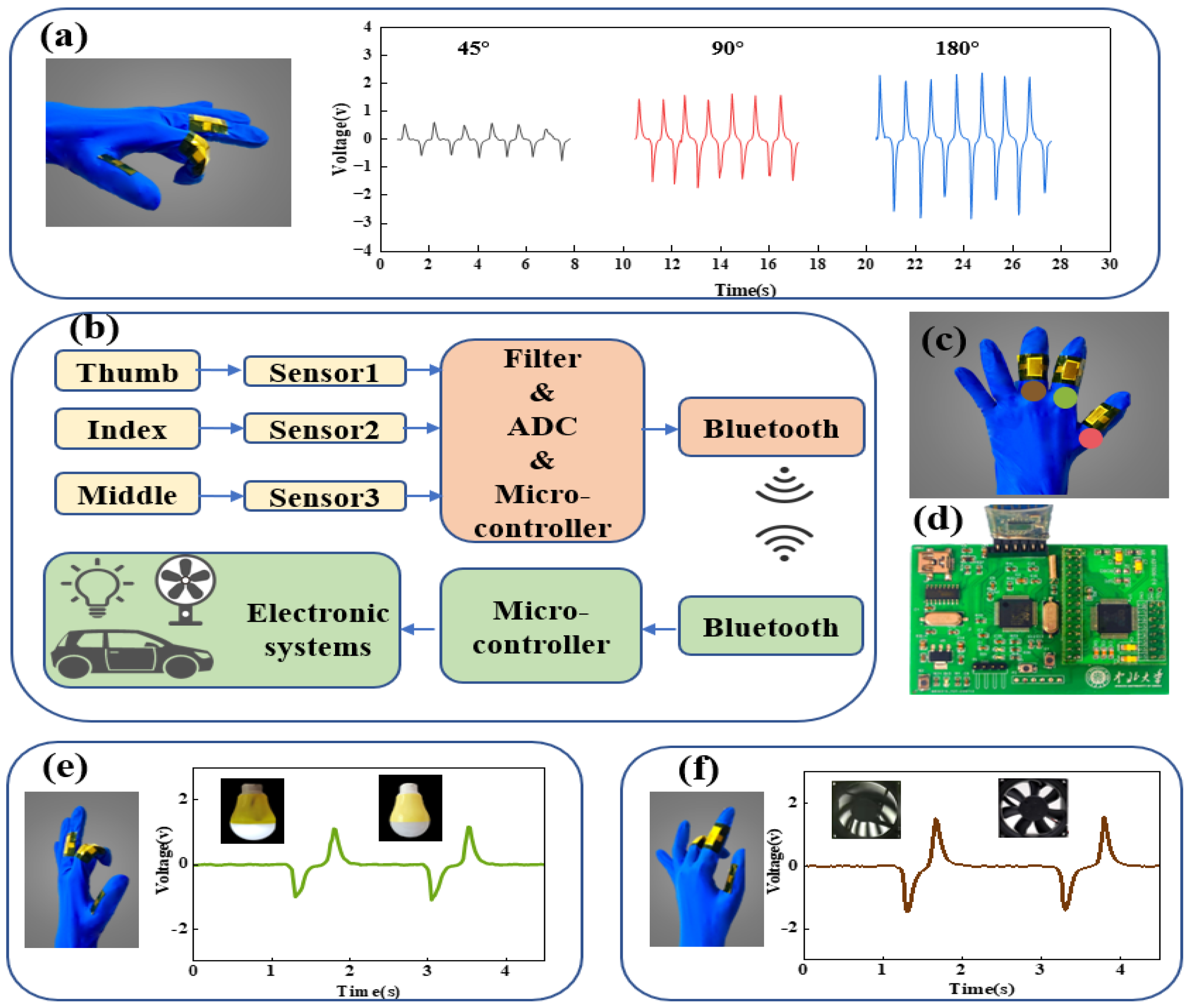An Intelligent Glove of Synergistically Enhanced ZnO/PAN-Based Piezoelectric Sensors for Diversified Human–Machine Interaction Applications
Abstract
1. Introduction
2. Materials and Methods
2.1. Materials
2.2. Fabrication of the ZnO/PAN-Based Piezoelectric Sensor (HFPS)
2.3. Characterization and Measurement
2.4. Human–Machine Interaction System
3. Results and Discussion
3.1. Morphology and Characterization of the Composite Membrane
3.2. Piezoelectric Performance of the HFPS
3.3. Human–Machine Interaction Application
4. Conclusions
Supplementary Materials
Author Contributions
Funding
Data Availability Statement
Conflicts of Interest
References
- Cao, J.; Fu, X.P.; Zhu, H.; Qu, Z.Q.; Qi, Y.C.; Zhang, Z.; Zhang, Z.Q.; Cheng, G.G.; Zhang, C.; Ding, J.N. Self-Powered Non-Contact Motion Vector Sensor for Multifunctional Human-Machine Interface. Small Methods 2022, 6, 8. [Google Scholar] [CrossRef]
- He, Q.; Feng, Z.P.; Wang, X.; Wu, Y.F.; Yang, J. A Smart Pen Based on Triboelectric Effects for Handwriting Pattern Tracking and Biometric Identification. ACS Appl. Mater. Interfaces 2022, 14, 49295–49302. [Google Scholar] [CrossRef]
- Hu, Z.Y.; Wang, J.P.; Wang, Y.; Wang, C.; Wang, Y.W.; Zhang, Z.Y.; Xu, P.; Zhao, T.C.; Luan, Y.; Liu, C.; et al. A Robust and Wearable Triboelectric Tactile Patch as Intelligent Human-Machine Interface. Materials 2021, 14, 6366. [Google Scholar] [CrossRef] [PubMed]
- Shi, Q.F.; Zhang, Z.X.; Chen, T.; Lee, C.K. Minimalist and multi-functional human machine interface (HMI) using a flexible wearable triboelectric patch. Nano Energy 2019, 62, 355–366. [Google Scholar] [CrossRef]
- Pang, Y.K.; Chen, S.; Cao, Y.T.; Huang, Z.D.; Xu, X.C.; Fang, Y.H.; Cao, C.Y. Self-Powered Multifunctional Human-Machine Interfaces for Respiratory Monitoring and Smart System Control. Adv. Mater. Interfaces 2022, 9, 8. [Google Scholar] [CrossRef]
- Goh, Q.L.; Chee, P.; Lim, E.H.; Liew, G.G. Self-powered pressure sensor based on microfluidic triboelectric principle for human-machine interface applications. Smart Mater. Struct. 2021, 30, 8. [Google Scholar] [CrossRef]
- Doganay, D.; Cicek, M.O.; Durukan, M.B.; Altuntas, B.; Agbahca, E.; Coskun, S.; Unalan, H.E. Fabric based wearable triboelectric nanogenerators for human machine interface. Nano Energy 2021, 89, 12. [Google Scholar] [CrossRef]
- Yu, J.B.; Hou, X.J.; Cui, M.; Zhang, S.N.; He, J.; Geng, W.P.; Mu, J.L.; Chou, X.J. Highly skin-conformal wearable tactile sensor based on piezoelectric-enhanced triboelectric nanogenerator. Nano Energy 2019, 64, 14. [Google Scholar] [CrossRef]
- Wang, L.L.; Liu, W.Q.; Yan, Z.G.; Wang, F.J.; Wang, X. Stretchable and Shape-Adaptable Triboelectric Nanogenerator Based on Biocompatible Liquid Electrolyte for Biomechanical Energy Harvesting and Wearable Human-Machine Interaction. Adv. Funct. Mater. 2021, 31, 10. [Google Scholar] [CrossRef]
- Zhu, M.L.; Sun, Z.D.; Zhang, Z.X.; Shi, Q.F.; He, T.Y.Y.; Liu, H.C.; Chen, T.; Lee, C.K. Haptic-feedback smart glove as a creative human-machine interface (HMI) for virtual/augmented reality applications. Sci. Adv. 2020, 6, 14. [Google Scholar] [CrossRef]
- Shi, Q.F.; Lee, C.K. Self-Powered Bio-Inspired Spider-Net-Coding Interface Using Single-Electrode Triboelectric Nanogenerator. Adv. Sci. 2019, 6, 13. [Google Scholar] [CrossRef] [PubMed]
- Guo, H.; Wan, J.; Wu, H.X.; Wang, H.B.; Miao, L.M.; Song, Y.; Chen, H.T.; Han, M.D.; Zhang, H.X. Self-Powered Multifunctional Electronic Skin for a Smart Anti-Counterfeiting Signature System. ACS Appl. Mater. Interfaces 2020, 12, 22357–22364. [Google Scholar] [CrossRef]
- Wang, L.Y.; Liu, Y.M.; Liu, Q.; Zhu, Y.Y.; Wang, H.Y.; Xie, Z.Q.; Yu, X.G.; Zi, Y.L. A metal-electrode-free, fully integrated, soft triboelectric sensor array for self-powered tactile sensing. Microsyst. Nanoeng. 2020, 6, 9. [Google Scholar] [CrossRef]
- Zhou, X.R.; Parida, K.; Halevi, O.; Magdassi, S.; Lee, P.S. All 3D Printed Stretchable Piezoelectric Nanogenerator for Self-Powered Sensor Application. Sensors 2020, 20, 6748. [Google Scholar] [CrossRef]
- Zhao, C.L.; Jia, C.J.; Zhu, Y.S.; Zhao, T.M. An Effective Self-Powered Piezoelectric Sensor for Monitoring Basketball Skills. Sensors 2021, 21, 5144. [Google Scholar] [CrossRef]
- He, T.; Sun, Z.; Shi, Q.; Zhu, M.; Anaya, D.V.; Xu, M.; Chen, T.; Yuce, M.R.; Thean, A.V.-Y.; Lee, C. Self-powered glove-based intuitive interface for diversified control applications in real/cyber space. Nano Energy 2019, 58, 641–651. [Google Scholar] [CrossRef]
- Guo, H.; Pu, X.; Jie, C.; Yan, M.; Min-Hsin, Y.; Liu, G.; Tang, Q.; Chen, B.; Di, L.; Song, Q.J.S.R. A highly sensitive, self-powered triboelectric auditory sensor for social robotics and hearing aids. Sci. Robot. 2018, 3, eaat2516. [Google Scholar] [CrossRef]
- Deng, W.L.; Yang, T.; Jin, L.; Yan, C.; Huang, H.C.; Chu, X.; Wang, Z.X.; Xiong, D.; Tian, G.; Gao, Y.Y.; et al. Cowpea-structured PVDF/ZnO nanofibers based flexible self-powered piezoelectric bending motion sensor towards remote control of gestures. Nano Energy 2019, 55, 516–525. [Google Scholar] [CrossRef]
- Gao, C.; Long, Z.; Zhong, T.; Liang, S.; Xing, L. A self-powered intelligent glove for real-time human-machine gesture interaction based on piezoelectric effect of T-ZnO/PVDF film. J. Phys. D Appl. Phys. 2022, 55, 516–525. [Google Scholar] [CrossRef]
- Mu, J.; Xian, S.; Yu, J.; Li, Z.; Zhao, J.; Zhong, J.; Han, X.; Hou, X.; He, J.; Chou, X. Flexible and wearable BaTiO3/polyacrylonitrile-based piezoelectric sensor for human posture monitoring. Sci. China Technol. Sci. 2022, 65, 858–869. [Google Scholar] [CrossRef]
- Qi, Y.; Kim, J.; Nguyen, T.D.; Lisko, B.; Purohit, P.K.; McAlpine, M.C. Enhanced piezoelectricity and stretchability in energy harvesting devices fabricated from buckled PZT ribbons. Nano Lett. 2011, 11, 1331–1336. [Google Scholar] [CrossRef] [PubMed]
- Kumar, M.; Kumari, P.; Sahatiya, P. P(VDF-TrFE)/ZnO nanofiber composite based piezoelectric nanogenerator as self-powered sensor: Fabrication and characterization. J. Polym. Res. 2022, 29, 44. [Google Scholar] [CrossRef]
- Yu, J.; Xian, S.; Zhang, Z.; Hou, X.; He, J.; Mu, J.; Geng, W.; Qiao, X.; Zhang, L.; Chou, X. Synergistic piezoelectricity enhanced BaTiO3/polyacrylonitrile elastomer-based highly sensitive pressure sensor for intelligent sensing and posture recognition applications. Nano Res. 2022, 1–13. [Google Scholar] [CrossRef]
- Wang, W.; Zheng, Y.; Jin, X.; Sun, Y.; Lu, B.; Wang, H.; Fang, J.; Shao, H.; Lin, T. Unexpectedly high piezoelectricity of electrospun polyacrylonitrile nanofiber membranes. Nano Energy 2019, 56, 588–594. [Google Scholar] [CrossRef]
- Tian, G.; Deng, W.; Gao, Y.; Xiong, D.; Yan, C.; He, X.; Yang, T.; Jin, L.; Chu, X.; Zhang, H.; et al. Rich lamellar crystal baklava-structured PZT/PVDF piezoelectric sensor toward individual table tennis training. Nano Energy 2019, 59, 574–581. [Google Scholar] [CrossRef]
- Sun, Y.; Liu, Y.; Zheng, Y.; Li, Z.; Fan, J.; Wang, L.; Liu, X.; Liu, J.; Shou, W. Enhanced Energy Harvesting Ability of ZnO/PAN Hybrid Piezoelectric Nanogenerators. ACS Appl. Mater. Interfaces 2020, 12, 54936–54945. [Google Scholar] [CrossRef]
- Thakur, P.; Kool, A.; Hoque, N.A.; Bagchi, B.; Khatun, F.; Biswas, P.; Brahma, D.; Roy, S.; Banerjee, S.; Das, S. Superior performances of in situ synthesized ZnO/PVDF thin film based self-poled piezoelectric nanogenerator and self-charged photo-power bank with high durability. Nano Energy 2018, 44, 456–467. [Google Scholar] [CrossRef]
- Rizzo, P.; Auriemma, F.; Guerra, G.; Petraccone, V.; Corradini, P. Conformational Disorder in the Pseudohexagonal Form of Atactic Polyacrylonitrile. Macromolecules 1996, 29, 8852–8861. [Google Scholar] [CrossRef]
- Hobson, R.J.; Windle, A.H. Crystalline structure of atactic polyacrylonitrile. Macromolecules 1993, 26, 6903–6907. [Google Scholar] [CrossRef]
- Minagawa, M.; Taira, T.; Yabuta, Y.; Nozaki, K.; Yoshii, F. An Anomalous Tacticity−Crystallinity Relationship: A WAXD Study of Stereoregular Isotactic (83−25) Poly(Acrylonitrile) Powder Prepared by Urea Clathrate Polymerization. Macromolecules 2001, 34, 3679–3683. [Google Scholar] [CrossRef]
- Bhunia, R.; Das, S.; Dalui, S.; Hussain, S.; Paul, R.; Bhar, R.; Pal, A.K. Flexible nano-ZnO/polyvinylidene difluoride piezoelectric composite films as energy harvester. Appl. Phys. A 2016, 122, 637. [Google Scholar] [CrossRef]






Disclaimer/Publisher’s Note: The statements, opinions and data contained in all publications are solely those of the individual author(s) and contributor(s) and not of MDPI and/or the editor(s). MDPI and/or the editor(s) disclaim responsibility for any injury to people or property resulting from any ideas, methods, instructions or products referred to in the content. |
© 2023 by the authors. Licensee MDPI, Basel, Switzerland. This article is an open access article distributed under the terms and conditions of the Creative Commons Attribution (CC BY) license (https://creativecommons.org/licenses/by/4.0/).
Share and Cite
Wang, M.; Hou, X.; Qian, S.; Xian, S.; Yu, J.; He, J.; Chou, X. An Intelligent Glove of Synergistically Enhanced ZnO/PAN-Based Piezoelectric Sensors for Diversified Human–Machine Interaction Applications. Electronics 2023, 12, 1782. https://doi.org/10.3390/electronics12081782
Wang M, Hou X, Qian S, Xian S, Yu J, He J, Chou X. An Intelligent Glove of Synergistically Enhanced ZnO/PAN-Based Piezoelectric Sensors for Diversified Human–Machine Interaction Applications. Electronics. 2023; 12(8):1782. https://doi.org/10.3390/electronics12081782
Chicago/Turabian StyleWang, Min, Xiaojuan Hou, Shuo Qian, Shuai Xian, Junbin Yu, Jian He, and Xiujian Chou. 2023. "An Intelligent Glove of Synergistically Enhanced ZnO/PAN-Based Piezoelectric Sensors for Diversified Human–Machine Interaction Applications" Electronics 12, no. 8: 1782. https://doi.org/10.3390/electronics12081782
APA StyleWang, M., Hou, X., Qian, S., Xian, S., Yu, J., He, J., & Chou, X. (2023). An Intelligent Glove of Synergistically Enhanced ZnO/PAN-Based Piezoelectric Sensors for Diversified Human–Machine Interaction Applications. Electronics, 12(8), 1782. https://doi.org/10.3390/electronics12081782







